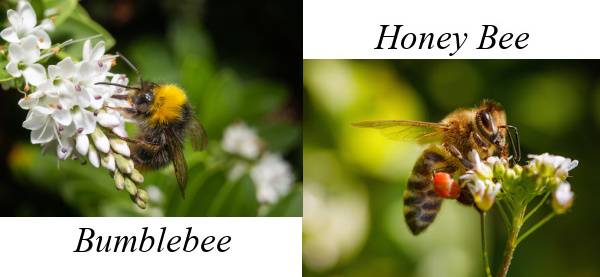Bumblebee
While there are over 250 species of bumblebee, the group is easily identified by their large, fuzzy appearance with short stubby wings. While this shape seems to defy aerodynamics, high-speed photography has shown these little guys have a unique way of flapping their tiny wings back-and-forth in a sweeping motion which creates vortices in the air like small hurricanes. For more on bumblebee flight, check out Joseph Calamia’s article.
Bumblebees are not aggressive. They sting when they or their nest is threatened and, unlike honeybees, they can sting multiple times. They are our most efficient pollinators and are crucial to crops; therefore, we do not exterminate, but relocate problem nests.
Honey Bee
There's a difference between Bumblebees and Honey Bees. The Western Honey Bee is most well known for their awesome nests with intricate wax structures, and they are popular for that delicious honey they produce. The Honey Bee is also not aggressive and will only sting when threatened.
The Honey Bee can only sting once though, and will die after inflicting the sting. They are dark brown with yellow stripes and tiny hairs, though not furry like a Bumblebee. They have huge eyes and a long stinger. If you are interested in learning more, I recommend the American Bee Journal.
The Honey Bee is also considered a non-target pest and should not be exterminated as they are critical to the environment and the food supply. If you are unsure what is nesting on your property, you can have a professional assess your situation and offer a solution.
The Difference Between Wasps, Hornets, and Yellowjackets
There are thousands of species of Wasps, Yellowjackets, and Hornets which can be broken down into two categories—social and solitary. Solitary Wasps, like mud daubers and paper wasps, rarely sting humans and use their stingers for subduing prey like spiders, crickets, and even caterpillars. Social Wasps, on the other hand, live in a nest which they build and defend as a collective, and their stinger is primarily used as a defensive tool.
While there are many species, most of us refer to all of them colloquially as Wasps or Yellowjackets. What many of us deal with is the Paper Wasp. They are ¾ to 1 inch in length, generally dark brown with yellow markings, and do not appear hairy as with the Bumblebee or Honey Bee. You will notice activity in spring and early summer, but they seem disinterested in you.
By Independence Day, though, they really pick up steam and are more emboldened to go after your hamburger and attack you at the smallest provocation. This is because early in the season they are busy building a nest while the queen is laying eggs—each hexagonal cell of the nest gets one egg. There is much work to be done, and they are focused on the work. Later in the season, they are focused on getting food and managing the colony—hence the aggressive stance on taking your dinner from you.
Another common invader is the German Yellowjacket. They are an invasive species and very aggressive. They build nests on, or in structures, often in the eves or even the attic of your home. They have a painful sting and will sting repeatedly to protect their nest.
How do I get rid of Wasps?
These buzzing pests should be eradicated as they are more than just a nuisance, they also attack bee colonies and help lead to the breakdown of that delicate ecosystem.
Your best defense in getting rid of Wasps and Yellowjackets is professional treatment. The spray foams you buy at the home center will kill the few Wasps you hit and that can certainly be satisfying, but it will not eliminate the problem.
Your pest control technician will remove all the nests they find and then treat the areas with an appropriate product depending on the situation. A professional will help you get the problem under control so you can get on with the business of summer—having fun.
For tips on safety precautions, read our post on Stinging Summer Pests.



